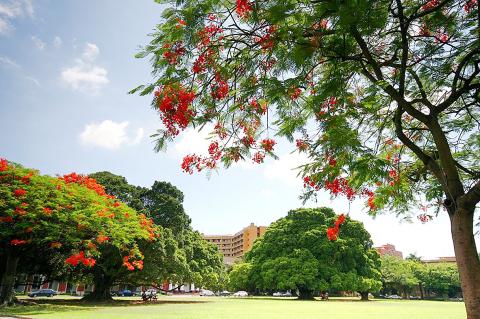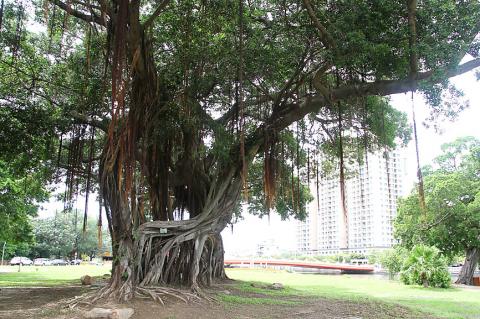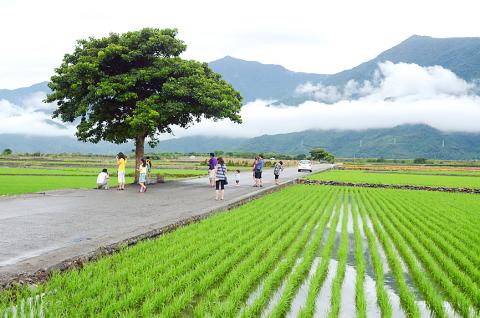While there are plenty of old banyan trees in Taiwan, none can be said to enjoy quite the same level of fame as a centennial banyan that grows at Greater Tainan’s Cheng Kung University and was the inspiration for Cathay Life Insurance Co’s tree-shaped logo.
Visitors stepping onto the university’s Guangfu campus are met with the sight of an idyllic meadow to their right, in the middle of which towers the imposing mushroom-shaped banyan. The 100-year-old tree is so massive that it dwarfs all the other banyans on campus.
It is said that the real-life Cathay Life banyan was planted by Japanese Emperor Showa in 1923 and that it is indigenous to Japan’s Kagoshima Prefecture.

Photo taken from Cheng Kung University’s Facebook page
Even so, the giant tree is not that special in the eyes of many locals, who are accustomed to the centennial banyans — a type of fig tree — ubiquitous across parks in Greater Tainan, standing out only for its sheer size.
As any celebrity knows, the road to fame often presents itself when one least expects it and so it was with the Guangfu banyan.
In 1995, Cathay Life donated NT$1 million (US$33,333) to adopt the tree and designed its trademark logo based on the tree’s mushroom-like silhouette.

Photo: CNA
Alongside the slogan: “Bury your roots deep to reach high,” the titanic banyan began appearing in print advertisements and TV commercials for the insurer nationwide, earning it overnight fame.
As a result of this publicity, tourists have swarmed to the university to marvel at the tree for the past 20 years, while the school’s administration often allows its banyan grove to be used a venue for events.
Cathay Life’s banyan has also became a landmark of Greater Tainan and a popular spot in which to play basketball, have a date or engage in a myriad of other leisure activities.

Photo: CNA
The banyan is not Taiwan’s only “celebrity” tree: A red cedar that grows at the end of Taitung County’s Brown Avenue also rose to fame, gaining nationwide recognition after Taiwanese-Japanese actor Takeshi Kaneshiro (金城武) was filmed having tea underneath it in a globally televised EVA Airways commercial earlier this year.
The cedar has since been dubbed the “Takeshi Kaneshiro Tree.”
The commercial, shot in Chihshang Township (池上), featured the superstar serving tea and cooling off under the shade of the red cedar. The ad became an overnight sensation as its depiction of leaving the busy city life behind to be immersed in nature resonated with many.
Wu Hsiu-lan (吳秀蘭), who owns the red cedar, said her father planted the tree 40 years ago so he and his buffalo could cool off in its shade.
The cedar’s popularity even prompted the Chihshang Township Office to list it as a cultural site and control traffic on the avenue running alongside it — an unprecedented move given that the avenue is listed as an agricultural road.
The tree, which has the potential of generating annual profits of up to NT$700 million, sparked a wave of panic when it was uprooted by Typhoon Matmo late last month.
Fortunately, thanks to the special attention it received from horticulturalists, it has been restored to an upright position.
Another famous banyan rivaling the Cheng Kung University landmark is the “lovey-dovey tree” that sits by the Greater Tainan canal.
The tree found instant fame after it was featured in several scenes of last year’s Taiwanese blockbuster Zone Pro Site (總舖師).
In one of the scenes, the film’s protagonists, A-hai (阿海) and Hsiaowan (小婉), a young couple, sit on top of the banyan’s roots, transforming it into a popular date spot overnight. Couples from across Taiwan now come to Greater Tainan to take pictures sitting on the tree’s roots.
Greater Tainan Tourism Bureau Director Chen Chun-an (陳俊安) said that despite the film star tree’s high profile, the city government chose not to further publicize it or establish any infrastructure in its surroundings because it wants to preserve the banyan so it continues to be the same healthy, imposing tree seen in the movie.
Stressing the importance of conservation, Chen urged visitors to bear in mind that the “lovey-dovey tree” may not be fit for climbing due to its age, suggesting that they just photograph it from a distance.

Taiwanese were praised for their composure after a video filmed by Taiwanese tourists capturing the moment a magnitude 7.5 earthquake struck Japan’s Aomori Prefecture went viral on social media. The video shows a hotel room shaking violently amid Monday’s quake, with objects falling to the ground. Two Taiwanese began filming with their mobile phones, while two others held the sides of a TV to prevent it from falling. When the shaking stopped, the pair calmly took down the TV and laid it flat on a tatami mat, the video shows. The video also captured the group talking about the safety of their companions bathing

US climber Alex Honnold is to attempt to scale Taipei 101 without a rope and harness in a live Netflix special on Jan. 24, the streaming platform announced on Wednesday. Accounting for the time difference, the two-hour broadcast of Honnold’s climb, called Skyscraper Live, is to air on Jan. 23 in the US, Netflix said in a statement. Honnold, 40, was the first person ever to free solo climb the 900m El Capitan rock formation in Yosemite National Park — a feat that was recorded and later made into the 2018 documentary film Free Solo. Netflix previewed Skyscraper Live in October, after videos

Starting on Jan. 1, YouBike riders must have insurance to use the service, and a six-month trial of NT$5 coupons under certain conditions would be implemented to balance bike shortages, a joint statement from transportation departments across Taipei, New Taipei City and Taoyuan announced yesterday. The rental bike system operator said that coupons would be offered to riders to rent bikes from full stations, for riders who take out an electric-assisted bike from a full station, and for riders who return a bike to an empty station. All riders with YouBike accounts are automatically eligible for the program, and each membership account

A classified Pentagon-produced, multiyear assessment — the Overmatch brief — highlighted unreported Chinese capabilities to destroy US military assets and identified US supply chain choke points, painting a disturbing picture of waning US military might, a New York Times editorial published on Monday said. US Secretary of Defense Pete Hegseth’s comments in November last year that “we lose every time” in Pentagon-conducted war games pitting the US against China further highlighted the uncertainty about the US’ capability to intervene in the event of a Chinese invasion of Taiwan. “It shows the Pentagon’s overreliance on expensive, vulnerable weapons as adversaries field cheap, technologically